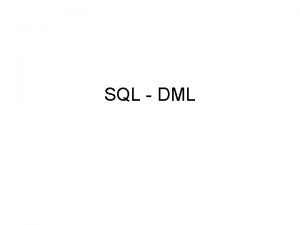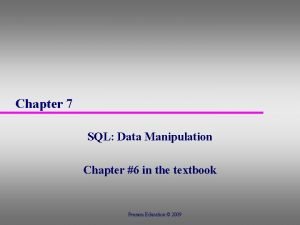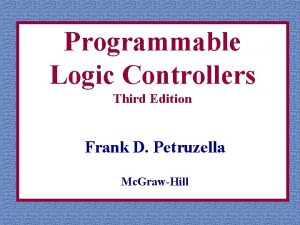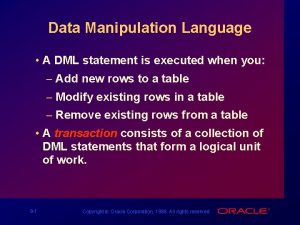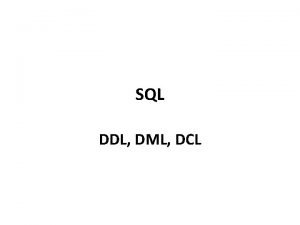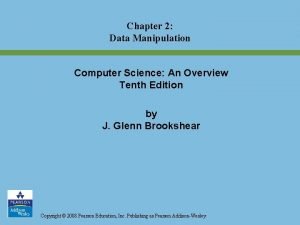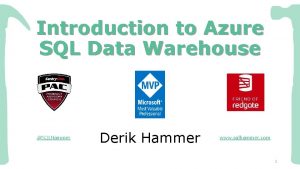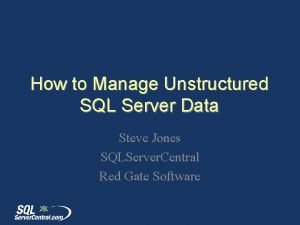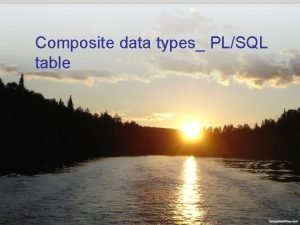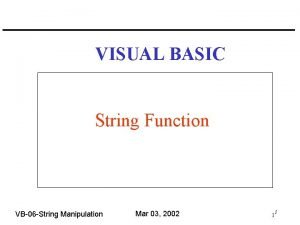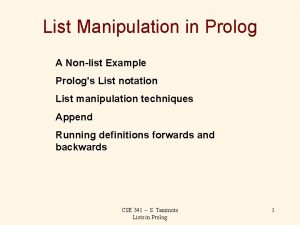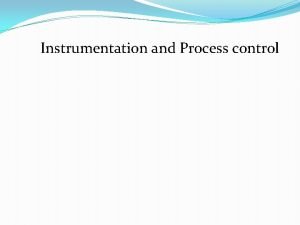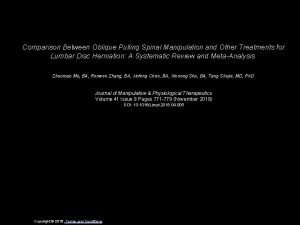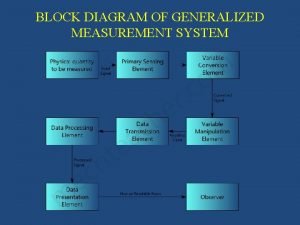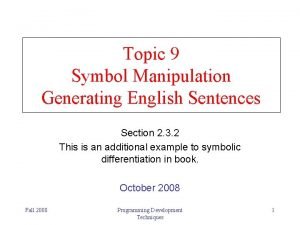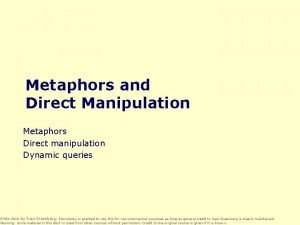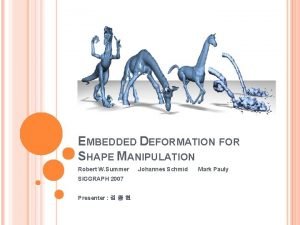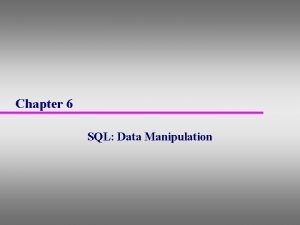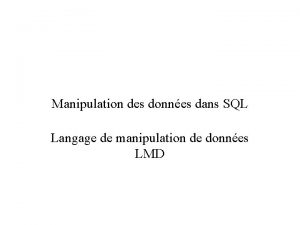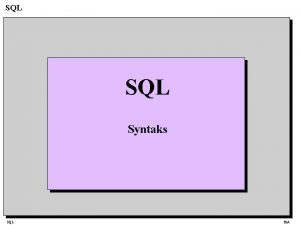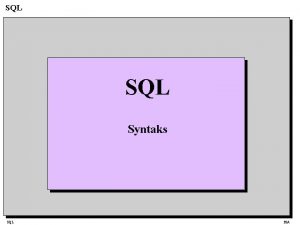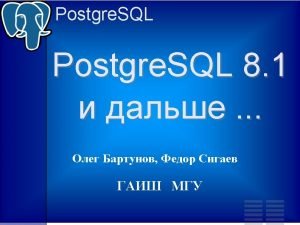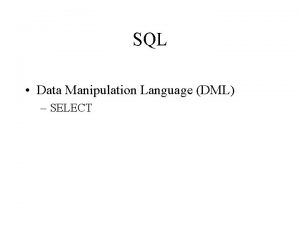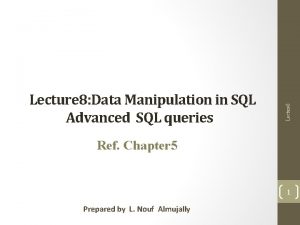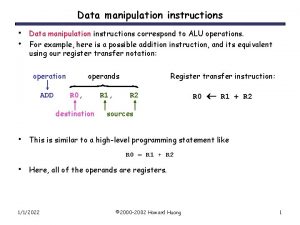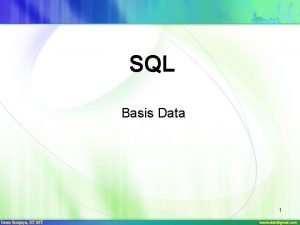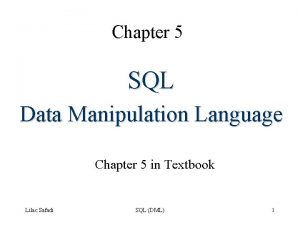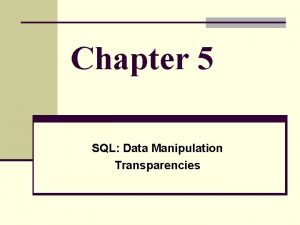Chapter 9 SQL Data Manipulation Chapter 6 in






![SELECT Statement SELECT [DISTINCT | ALL] {* | [column. Expression [AS new. Name]] [, SELECT Statement SELECT [DISTINCT | ALL] {* | [column. Expression [AS new. Name]] [,](https://slidetodoc.com/presentation_image_h2/b1b0a3588cd2365b1e9f4c7ffac4b9af/image-7.jpg)
















































![INSERT INTO Table. Name [ (column. List) ] VALUES (data. Value. List) u column. INSERT INTO Table. Name [ (column. List) ] VALUES (data. Value. List) u column.](https://slidetodoc.com/presentation_image_h2/b1b0a3588cd2365b1e9f4c7ffac4b9af/image-56.jpg)











![DELETE FROM Table. Name [WHERE search. Condition] u Table. Name can be name of DELETE FROM Table. Name [WHERE search. Condition] u Table. Name can be name of](https://slidetodoc.com/presentation_image_h2/b1b0a3588cd2365b1e9f4c7ffac4b9af/image-68.jpg)

- Slides: 69

Chapter 9 SQL: Data Manipulation Chapter #6 in the textbook Pearson Education © 2009

Chapter 9 - Objectives u Purpose and importance of SQL. u How to retrieve data from database using SELECT. u How to update database using INSERT, UPDATE, and DELETE. Pearson Education © 2009 2

Objectives of SQL u Ideally, user to: database language should allow – Create the database and relation structures; – Perform insertion, modification, deletion of data from relations; – Perform simple and complex queries. u SQL is a transform-oriented language with 2 major components: – A DDL for defining database structure. – A DML for retrieving and updating data. Pearson Education © 2009 3

Objectives of SQL u SQL is relatively easy to learn: – it is non-procedural - you specify what information you require, rather than how to get it – it is essentially free-format - some sentences do not have to be in particular location Pearson Education © 2009 4

Writing SQL Commands u Most components of an SQL statement are case insensitive, except for literal character data. u Use extended form of BNF notation: - Upper-case letters represent reserved words. - Lower-case letters represent user-defined words. - | indicates a choice among alternatives. - Curly braces { } indicate a required element. - Square brackets [ ] indicate an optional element. - … indicates optional repetition (0 or more). Pearson Education © 2009 5

Literals u Literals are constants used in SQL statements. u All non-numeric literals must be enclosed in single quotes. e. g. ‘London’ u All numeric literals must not be enclosed in quotes e. g. 650. 00 Pearson Education © 2009 6
![SELECT Statement SELECT DISTINCT ALL column Expression AS new Name SELECT Statement SELECT [DISTINCT | ALL] {* | [column. Expression [AS new. Name]] [,](https://slidetodoc.com/presentation_image_h2/b1b0a3588cd2365b1e9f4c7ffac4b9af/image-7.jpg)
SELECT Statement SELECT [DISTINCT | ALL] {* | [column. Expression [AS new. Name]] [, . . . ] } FROM Table. Name [alias] [, . . . ] [WHERE condition] [GROUP BY column. List] [HAVING condition] [ORDER BY column. List] FROM WHERE GROUP BY HAVING SELECT ORDER BY Specifies table(s) to be used. Filters rows. Forms groups of rows with same column value. Filters groups subject to some condition. Specifies which columns are to appear in output. Specifies the order of the output. u Order of the clauses cannot be changed. u Pearson Education © 2009 Only SELECT and FROM are mandatory 7

Example 6. 1 All Columns, All Rows List full details of all staff. SELECT staff. No, f. Name, l. Name, address, position, sex, DOB, salary, branch. No FROM Staff; u Can use * as an abbreviation for ‘all columns’: SELECT * FROM Staff; Pearson Education © 2009 8

Example 6. 1 All Columns, All Rows Pearson Education © 2009 9

Example 6. 2 Specific Columns, All Rows Produce a list of salaries for all staff, showing only staff number, first and last names, and salary. SELECT staff. No, f. Name, l. Name, salary FROM Staff; Pearson Education © 2009 10

Example 6. 2 Specific Columns, All Rows Pearson Education © 2009 11

Example 6. 3 Use of DISTINCT u Use DISTINCT to eliminate duplicates: SELECT DISTINCT property. No FROM Viewing; Pearson Education © 2009 12

Example 6. 4 Calculated Fields Produce list of monthly salaries for all staff, showing staff number, first/last name, and salary. SELECT staff. No, f. Name, l. Name, salary/12 FROM Staff; 13 Pearson Education © 2009

Example 6. 4 Calculated Fields u To name column, use AS clause: SELECT staff. No, f. Name, l. Name, salary/12 AS monthly. Salary FROM Staff; u The SQL expression in the SELECT list can specify a derived or calculated field. – Columns referenced in the arithmetic expression must have a numeric type. – SQL expression can involve + , - , * , / , ( , ). Pearson Education © 2009 14

Row Selection (WHERE clause) WHERE clause consists of five basic search conditions: § Comparison: Compare the value of one expression to the value of another expression (= , <, >, <=, >=, < >). § Range: Test whether the value of an expression falls within a specified range of values (BETWEEN/ NOT BETWEEN). § Set membership: Test whether the value of an expression equals one of a set of values (IN/ NOT IN). § Pattern match: Test whether a string matches a specified pattern (LIKE/ NOT LIKE). § NULL: Test whether a column has null value (IS NULL/ IS NOT NULL). SQL (DML) 15

Example 6. 5 Comparison Search Condition u u Compound comparison operators: AND, OR, NOT, ( ) Order of evaluation: (1)Expression is evaluated left to right (2)Between brackets (3)NOT (4)AND (5)OR List all staff with a salary greater than 10, 000. SELECT staff. No, f. Name, l. Name, position, salary FROM Staff WHERE salary > 10000; Pearson Education © 2009 16

Example 6. 6 Compound Comparison Search Condition List addresses of all branch offices in London or Glasgow. Branch (branch. No, street , city, postcode) SELECT * FROM Branch WHERE city = ‘London’ OR city = ‘Glasgow’; Pearson Education © 2009 17

Example 6. 7 Range Search Condition List all staff with a salary between 20, 000 and 30, 000. SELECT staff. No, f. Name, l. Name, position, salary FROM Staff WHERE salary BETWEEN 20000 AND 30000; u BETWEEN test includes the endpoints of range. Pearson Education © 2009 18

Example 6. 7 Range Search Condition Pearson Education © 2009 19

Example 6. 7 Range Search Condition u Also a negated version NOT BETWEEN. u BETWEEN does not add much to SQL’s expressive power. Could also write: SELECT staff. No, f. Name, l. Name, position, salary FROM Staff WHERE salary>=20000 AND salary <= 30000; u Useful, though, for a range of values. Pearson Education © 2009 20

Example 6. 8 Set Membership List all managers and supervisors. SELECT staff. No, f. Name, l. Name, position FROM Staff WHERE position IN (‘Manager’, ‘Supervisor’); Pearson Education © 2009 21

Example 6. 8 Set Membership There is a negated version (NOT IN). u IN does not add much to SQL’s expressive power. Could have expressed this as: u SELECT staff. No, f. Name, l. Name, position FROM Staff WHERE position=‘Manager’ OR position=‘Supervisor’; u IN is more efficient when set contains many values. Pearson Education © 2009 22

Example 6. 9 Pattern Matching Find all owners with the string ‘Glasgow’ in their address. SELECT owner. No, f. Name, l. Name, address, tel. No FROM Private. Owner WHERE address LIKE ‘%Glasgow%’; Pearson Education © 2009 23

Example 6. 9 Pattern Matching u SQL has two special pattern matching symbols: %: sequence of zero or more characters _ (underscore): any single character. u LIKE ‘%Glasgow%’ means a sequence of characters of any length containing ‘Glasgow’. Pearson Education © 2009 24

Example 6. 10 NULL Search Condition List details of all viewings on property PG 4 where a comment has not been supplied. Viewing (Property. No, Comments) u u Renter. No, Date. Viewed, There are 2 viewings for property PG 4, one with and one without a comment. Have to test for null explicitly using special keyword IS NULL: SELECT client. No, view. Date FROM Viewing WHERE property. No = ‘PG 4’ AND comment IS NULL; Pearson Education © 2009 25

Example 6. 10 NULL Search Condition u Negated version (IS NOT NULL) can test for non-null values. Pearson Education © 2009 26

Example 6. 11 Single Column Ordering Order by: allow the retrieved records to be ordered in ascending (ASC) or descending order (DESC) on any column or combination of columns. List salaries for all staff, arranged in descending order of salary. SELECT staff. No, f. Name, l. Name, salary FROM Staff ORDER BY salary DESC; Pearson Education © 2009 27

Example 6. 11 Single Column Ordering Pearson Education © 2009 28

Example 6. 12 Multiple Column Ordering Produce abbreviated list of properties in order of property type Property. For. Rent (Property. No, Street, Area, City, Postcode, Type, Rooms, Rent, Private. Owner. No, Business. Owner. No, Staff. No, Branch. No, Picture, Comments, Withdrawn, Delete. Record) SELECT property. No, type, rooms, rent FROM Property. For. Rent ORDER BY type; Pearson Education © 2009 29

Example 6. 12 Multiple Column Ordering Pearson Education © 2009 30

Example 6. 12 Multiple Column Ordering u Four flats in this list - as no minor sort key specified, system arranges these rows in any order it chooses. u To arrange in order of rent, specify minor order: SELECT property. No, type, rooms, rent FROM Property. For. Rent ORDER BY type, rent DESC; Pearson Education © 2009 31

Example 6. 12 Multiple Column Ordering Pearson Education © 2009 32

SELECT Statement - Aggregates u ISO standard defines five aggregate functions: – COUNT returns number of values in specified column. – SUM returns sum of values in specified column. – AVG returns average of values in specified column. – MIN returns smallest value in specified column. – MAX returns largest value in specified column. Pearson Education © 2009 33

SELECT Statement - Aggregates u Each operates on a single column of a table and returns a single value. u COUNT, MIN, and MAX apply to numeric and nonnumeric fields, but SUM and AVG may be used on numeric fields only. u Apart from COUNT(*), each function eliminates nulls first and operates only on remaining non-null values. Pearson Education © 2009 34

SELECT Statement - Aggregates u COUNT(*) counts all rows of a table, regardless of whether nulls or duplicate values occur. u Can use DISTINCT before column name to eliminate duplicates. u DISTINCT has no effect with MIN/MAX, but may have with SUM/AVG. Pearson Education © 2009 35

SELECT Statement - Aggregates u Aggregate functions can be used only in SELECT list and in HAVING clause. u If SELECT list includes an aggregate function and there is no GROUP BY clause, SELECT list cannot reference a column out with an aggregate function. u For example, the following is illegal: SELECT staff. No, COUNT(salary) FROM Staff; Pearson Education © 2009 36

Example 6. 13 Use of COUNT(*) How many properties cost more than £ 350 per month to rent? Property. For. Rent (Property. No, Street, Area, City, Postcode, Type, Rooms, Rent, Private. Owner. No, Business. Owner. No, Staff. No, Branch. No, Picture, Comments, Withdrawn, Delete. Record) SELECT COUNT(*) AS my. Count FROM Property. For. Rent WHERE rent > 350; Pearson Education © 2009 37

Example 6. 14 Use of COUNT(DISTINCT) How many different properties viewed in May ‘ 04? u Property. For. Rent (Property. No, Street, Area, City, Postcode, Type, Rooms, Rent, Private. Owner. No, Business. Owner. No, Staff. No, Branch. No, Picture, Comments, Withdrawn, Delete. Record) u Viewing (Property. No, Renter. No, Date. Viewed, Comments) SELECT COUNT(DISTINCT property. No) AS my. Count FROM Viewing WHERE view. Date BETWEEN ‘ 1 -May-04’ AND ‘ 31 -May-04 Pearson Education © 2009 38

Example 6. 15 Use of COUNT and SUM Find number of Managers and sum of their salaries. SELECT COUNT(staff. No) AS my. Count, SUM(salary) AS my. Sum FROM Staff WHERE position = ‘Manager’; 39 Pearson Education © 2009

Example 6. 16 Use of MIN, MAX, AVG Find minimum, maximum, and average staff salary. SELECT MIN(salary) AS my. Min, MAX(salary) AS my. Max, AVG(salary) AS my. Avg FROM Staff; Pearson Education © 2009 40

GROUP BY clause sno salary B 003 SG 37 SG 14 12000 18000 count sum B 003 SG 5 24000 3 54000 B 005 SL 21 30000 2 39000 B 005 SL 41 9000 B 007 SA 9 9000 bno SQL (DML) 41

SELECT Statement - Grouping u Use GROUP BY clause to get sub-totals. u SELECT and GROUP BY closely integrated: each item in SELECT list must be single-valued per group, and SELECT clause may only contain: – – Column names Aggregate functions Constants Expression involving combinations of the above. Pearson Education © 2009 42

SELECT Statement - Grouping u All column names in SELECT list must appear in GROUP BY clause unless name is used only in an aggregate function. u If WHERE is used with GROUP BY, WHERE is applied first, then groups are formed from remaining rows satisfying predicate. Pearson Education © 2009 43

Example 6. 17 Use of GROUP BY Find number of staff in each branch and their total salaries. SELECT branch. No, COUNT(staff. No) AS my. Count, SUM(salary) AS my. Sum FROM Staff GROUP BY branch. No ORDER BY branch. No; Pearson Education © 2009 44

Restricted Groupings – HAVING clause u HAVING clause is designed for use with GROUP BY to restrict groups that appear in final result table. u Similar to WHERE, but WHERE filters individual rows whereas HAVING filters groups. u Column names in HAVING clause must also appear in the GROUP BY list or be contained within an aggregate function. Pearson Education © 2009 45

Example 6. 18 Use of HAVING For each branch with more than 1 member of staff, find number of staff in each branch and sum of their salaries. SELECT branch. No, COUNT(staff. No) AS my. Count, SUM(salary) AS my. Sum FROM Staff GROUP BY branch. No HAVING COUNT(staff. No) > 1 ORDER BY branch. No; Pearson Education © 2009 46

Multi-Table Queries u Can use subqueries provided result columns come from same table. u If result columns come from more than one table must use a join. u To perform join, include more than one table in FROM clause. Use comma as separator and typically include WHERE clause to specify join column(s). Pearson Education © 2009 47

Multi-Table Queries u Also possible to use an alias for a table named in FROM clause. u Alias is separated from table name with a space. u Alias can be used to qualify column names when there is ambiguity. Pearson Education © 2009 48

Example 6. 24 Simple Join List names of all clients who have viewed a property along with any comment supplied. SELECT c. client. No, f. Name, l. Name, property. No, comment FROM Client c, Viewing v WHERE c. client. No = v. client. No; Pearson Education © 2009 49

Example 6. 24 Simple Join u Only those rows from both tables that have identical values in the client. No columns (c. client. No = v. client. No) are included in result. u Equivalent to equi-join in relational algebra. Pearson Education © 2009 50

Alternative JOIN Constructs u SQL provides alternative ways to specify joins: FROM Client c JOIN Viewing v ON c. client. No = v. client. No FROM Client JOIN Viewing USING client. No FROM Client NATURAL JOIN Viewing u In each case, FROM replaces original FROM and WHERE. However, the first one produces table with two identical client. No columns. Pearson Education © 2009 51

Example 6. 25 Sorting a join u u u PROPERTYFORRENT (pno, street, area, city, pcode, type, rooms, rent, sno) STAFF (sno, fname, lname, position, sex, DOB, salary, bno) BRANCH (bno, street, city, postcode) For each branch, list numbers and names of staff who manage properties, and properties they manage. SELECT s. bno, s. sno, f. Name, l. Name, p. No FROM Staff s, Property. For. Rent p WHERE s. sno = p. sno ORDER BY s. bno, s. sno, p. No; Pearson Education © 2009 52

Example 6. 25 Sorting a join Pearson Education © 2009 53

Example 6. 26 Three Table Join For each branch, list staff who manage properties, including city in which branch is located and properties they manage. SELECT s. bno, b. city , s. sno, f. Name, l. Name, p. No FROM Staff s, Property. For. Rent p , Branch b WHERE s. sno = p. sno AND b. bno=s. bno ORDER BY s. bno, s. sno, p. No; Pearson Education © 2009 54

Example 6. 27 Multiple Grouping Columns Find number of properties handled by each staff member, along with the branch number of the member of staff SELECT s. branch. No, s. staff. No, COUNT(*) AS my. Count FROM Staff s, Property. For. Rent p WHERE s. staff. No = p. staff. No GROUP BY s. branch. No, s. staff. No ORDER BY s. branch. No, s. staff. No; Pearson Education © 2009 55
![INSERT INTO Table Name column List VALUES data Value List u column INSERT INTO Table. Name [ (column. List) ] VALUES (data. Value. List) u column.](https://slidetodoc.com/presentation_image_h2/b1b0a3588cd2365b1e9f4c7ffac4b9af/image-56.jpg)
INSERT INTO Table. Name [ (column. List) ] VALUES (data. Value. List) u column. List is optional; if omitted, SQL assumes a list of all columns in their original CREATE TABLE order. u Any columns omitted must have been declared as NULL when table was created, unless DEFAULT was specified when creating column. Pearson Education © 2009 56

INSERT u data. Value. List must match column. List as follows: – number of items in each list must be same; – must be direct correspondence in position of items in two lists; – data type of each item in data. Value. List must be compatible with data type of corresponding column. Pearson Education © 2009 57

Example 6. 35 INSERT … VALUES u STAFF(sno, fname, lname, position, sex, DOB, salary, bno) Insert a new row into Staff table supplying data for all columns. INSERT INTO Staff VALUES (‘SG 16’, ‘Alan’, ‘Brown’, ‘Assistant’, ‘M’, Date‘ 1957 -05 -25’, 8300, ‘B 003’); Pearson Education © 2009 58

Example 6. 36 INSERT using Defaults STAFF(sno, fname, lname, position, sex, DOB, salary, bno) Insert a new row into Staff table supplying data for all mandatory columns. INSERT INTO Staff (staff. No, f. Name, l. Name, position, salary, branch. No) VALUES (‘SG 44’, ‘Anne’, ‘Jones’, ‘Assistant’, 8100, ‘B 003’); u Or INSERT INTO Staff VALUES (‘SG 44’, ‘Anne’, ‘Jones’, ‘Assistant’, NULL, 8100, ‘B 003’); Pearson Education © 2009 59

INSERT … SELECT u Second form of INSERT allows multiple rows to be copied from one or more tables to another: INSERT INTO Table. Name [ (column. List) ] SELECT. . . Pearson Education © 2009 60

Example 6. 37 INSERT … SELECT u Assume there is a table Staff. Prop. Count that contains names of staff and number of properties they manage: Staff. Prop. Count(staff. No, f. Name, l. Name, prop. Cnt) u Populate Staff. Prop. Count Property. For. Rent tables. using Staff and STAFF(sno, fname, lname, position, sex, DOB, salary, bno) PROPERTYFORRENT(Pno, street, city, postcode, type, rooms, rent, ono, sno, bno) Pearson Education © 2009 61

Example 6. 37 INSERT … SELECT INSERT INTO Staff. Prop. Count (SELECT s. staff. No, f. Name, l. Name, COUNT(*) FROM Staff s, Property. For. Rent p WHERE s. staff. No = p. staff. No GROUP BY s. staff. No, f. Name, l. Name) UNION (SELECT staff. No, f. Name, l. Name, 0 FROM Staff WHERE staff. No NOT IN (SELECT DISTINCT staff. No FROM Property. For. Rent)); Pearson Education © 2009 62

Example 6. 37 INSERT … SELECT u If second part of UNION is omitted, excludes those staff who currently do not manage any properties. Pearson Education © 2009 63

UPDATE Table. Name SET column. Name 1 = data. Value 1 [, column. Name 2 = data. Value 2. . . ] [WHERE search. Condition] u Table. Name can be name of a base table or an updatable view. u SET clause specifies names of one or more columns that are to be updated. Pearson Education © 2009 64

UPDATE u WHERE clause is optional: – if omitted, named columns are updated for all rows in table; – if specified, only those rows that satisfy search. Condition are updated. u New data. Value(s) must be compatible with data type for corresponding column. Pearson Education © 2009 65

Example 6. 38/39 UPDATE All Rows Give all staff a 3% pay increase. UPDATE Staff SET salary = salary*1. 03; Give all Managers a 5% pay increase. UPDATE Staff SET salary = salary*1. 05 WHERE position = ‘Manager’; Pearson Education © 2009 66

Example 6. 40 UPDATE Multiple Columns Promote David Ford (staff. No=‘SG 14’) to Manager and change his salary to £ 18, 000. UPDATE Staff SET position = ‘Manager’, salary = 18000 WHERE staff. No = ‘SG 14’; Pearson Education © 2009 67
![DELETE FROM Table Name WHERE search Condition u Table Name can be name of DELETE FROM Table. Name [WHERE search. Condition] u Table. Name can be name of](https://slidetodoc.com/presentation_image_h2/b1b0a3588cd2365b1e9f4c7ffac4b9af/image-68.jpg)
DELETE FROM Table. Name [WHERE search. Condition] u Table. Name can be name of a base table or an updatable view. u search. Condition is optional; if omitted, all rows are deleted from table. This does not delete table. u If search_condition is specified, only those rows that satisfy condition are deleted. Pearson Education © 2009 68

Example 6. 41/42 DELETE Specific Rows Delete all viewings that relate to property PG 4. DELETE FROM Viewing WHERE property. No = ‘PG 4’; Delete all records from the Viewing table. DELETE FROM Viewing; Pearson Education © 2009 69
 Is select a dml command
Is select a dml command The sql data manipulation command having
The sql data manipulation command having Generic components of ooa model
Generic components of ooa model Difference between sql and pl/sql
Difference between sql and pl/sql Sql developer unit testing
Sql developer unit testing Data manipulation instructions in plc
Data manipulation instructions in plc Data manipulation language dml
Data manipulation language dml Ddl dml dcl
Ddl dml dcl Data structures polynomial addition
Data structures polynomial addition Data manipulation vulnerability
Data manipulation vulnerability Data manipulation instructions in plc
Data manipulation instructions in plc Data manipulation in computer architecture
Data manipulation in computer architecture Manipulation of data
Manipulation of data Confidential computing
Confidential computing Parallel data warehouse sql server 2012
Parallel data warehouse sql server 2012 Spark sql: relational data processing in spark
Spark sql: relational data processing in spark Master data management sql server 2016
Master data management sql server 2016 Azure sql data warehouse dwu
Azure sql data warehouse dwu Azure sql data warehouse mpp
Azure sql data warehouse mpp Sql master data services
Sql master data services Polybase query service for external data
Polybase query service for external data Azure sql analytics
Azure sql analytics Varbinary in sql server
Varbinary in sql server Composite data types in pl sql
Composite data types in pl sql Azure sql data warehouse
Azure sql data warehouse Sql aqua data studio
Sql aqua data studio What is the result of the following 'vik'||null||'ram'?
What is the result of the following 'vik'||null||'ram'? Oracle big data appliance
Oracle big data appliance Perintah memperbaiki data per record
Perintah memperbaiki data per record Sql server change data capture vs temporal tables
Sql server change data capture vs temporal tables Sql*net more data from dblink
Sql*net more data from dblink Cdc sql server 2014
Cdc sql server 2014 Mpdwsvc.exe
Mpdwsvc.exe Visual basic string
Visual basic string String manipulation
String manipulation String manipulation in java
String manipulation in java Manipulation von schutzeinrichtungen
Manipulation von schutzeinrichtungen Knowledge manipulation in ai
Knowledge manipulation in ai Dédoublement manipulation syntaxique
Dédoublement manipulation syntaxique Cycle of manipulation
Cycle of manipulation C string manipulation
C string manipulation Variable manipulation element
Variable manipulation element Mass manipulation meaning
Mass manipulation meaning Berikut ini yang bukan sasaran dari file system adalah
Berikut ini yang bukan sasaran dari file system adalah List manipulation in prolog
List manipulation in prolog Manipulation in macbeth quotes
Manipulation in macbeth quotes Self operated and power operated instruments
Self operated and power operated instruments Jc 2000h , jump takes place when cy=0 cy=1 zf=0 zf=1
Jc 2000h , jump takes place when cy=0 cy=1 zf=0 zf=1 Inlay wax manipulation
Inlay wax manipulation Uses of inlay wax
Uses of inlay wax Kausal adalah
Kausal adalah Corrective wax
Corrective wax Explain the concept of direct manipulation
Explain the concept of direct manipulation Define manipulation check
Define manipulation check Psychomotor domain verbs list
Psychomotor domain verbs list Oblique pulling spinal manipulation
Oblique pulling spinal manipulation Noncontingent reinforcement functions as a:
Noncontingent reinforcement functions as a: Variable manipulation element
Variable manipulation element Manipulation in psychomotor domain
Manipulation in psychomotor domain Block diagram of a measurement system
Block diagram of a measurement system What's manipulation
What's manipulation Ateliers individuels de manipulation
Ateliers individuels de manipulation Algebraic manipulation gcse
Algebraic manipulation gcse Header manipulation: cookies
Header manipulation: cookies Manipulation definition
Manipulation definition Symbol manipulation example
Symbol manipulation example Metaphor for manipulation
Metaphor for manipulation Quote manipulation
Quote manipulation General image manipulation program
General image manipulation program Embedded deformation for shape manipulation
Embedded deformation for shape manipulation
